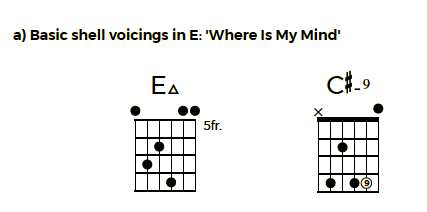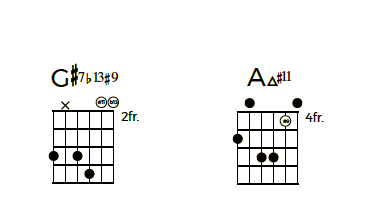Shell voicings are a staple of guitar playing since the beginning of jazz guitar. Players like Django Reinhardt or Eddie Lang already used them to play rhythm guitar and there are a number of benefits to this ‘reduced’ way of playing chords.
Obviously, less notes mean that they’re easier on our hands – additionally, the constant structure and limited number of different chord ‘grips’ allows the shapes to be more moveable across the neck. Practical for rhythm playing or easier transposition.
Define shell voicing ? It’s the term for a type of chord shape that includes all the necessary chord tone categories which define the distinctive sound of a given harmony:
- Root / 9
- 3 / b3 Major or minor chord
- 7 / b7 – Major 7, minor 7, dim 7
The following two formulas show how standard shell voicings are usually constructed, most often starting on the low E or A string:
a) root – (b) 3rd – (b) 7th
b) root – (b) 7th – (b) 3rd
Generally, the 5th interval is omitted since it is a less important chord tone category in this context. It can still be used to modify shell voicings for a different sound, e.g. to create voicings without a (b)3rd interval for a less definitive, ‘open’ sound. The same applies for the root category: exchanging the root with the 9, especially when played in the lower register can be used to create lush sounding pads, especially in conjunction with open strings.
Additionally, shell voicings are the basis of other common jazz voicings – just add color notes like in the sample below to create more complex harmonies. The black dots in the chord diagrams depict chord tones / the shell voicing, the white dots show tensions [ e.g. 9, b13 ].


The following mini etude is a good start to get the basic shell voicing shaped under your fingers and their distinctive sound into your personal ‘soundgarden’ – be sure to listen actively how the different chord types sound to get the most out of it. It also doubles as fingerpicking or string-skipping exercises, your choice 🙂


